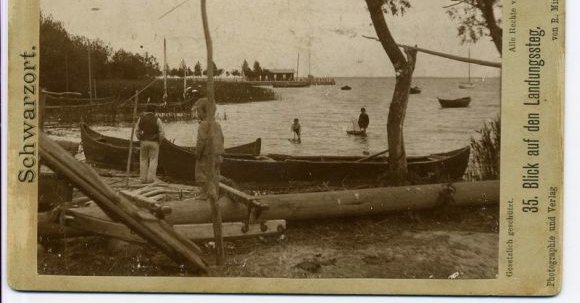
[ad_1]
According to the author, several conditions were important for the appearance of tourist complexes, including Juodkrante, objective and subjective. Among the objectives, industrialization at that time, the enrichment of people belonging to the middle class, they could afford vacations (previously this was only possible for aristocrats), and legal license also appeared. As demand arose, so did supply, and resorts began to take shape, and their true boom began in the mid-1800s, and most resorts developed into fishing villages. “The creators of the Juodkrante resort jumped on the train, and not one of the last cars, but one of the first,” said the book’s author.
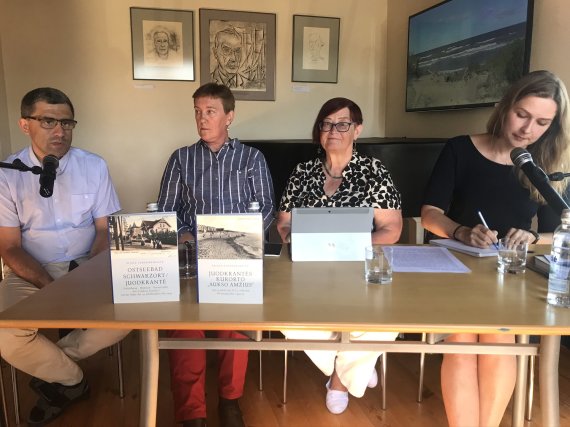
Photo of Audrius Ožalas / 15min / Nijolė Strakauskaitė – second from left
An important factor was regular communication with the Curonian Lagoon, which led to the increasing number of Klaipeda residents who want to spend Sundays and subsequent vacations in Juodkrante. According to the book, “the fact that Juodkrante was already an attractive place for Klaipeda’s weekend trips as early as the 1960s is evidenced in the press information: on a Sunday in June 1857, even four steamboats – Terra, Stella, Reindeer, Friedrich Wilhelm – they brought a large audience to hear the concert, organized by the Edel Singers Association of Klaipeda ”.
Juodkrante’s population increase is also associated with the activities of the amber mining company Stantien & Becker, founded in 1861 – interest in it quickly spread.
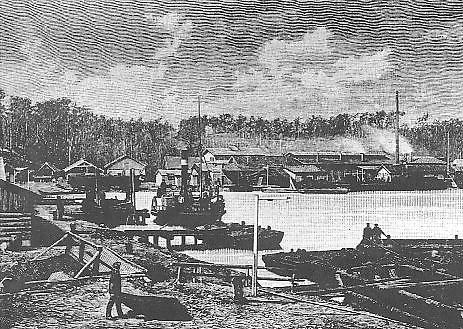
Photo from Wikimedia.org / Lithuanian coastline: Juodkrante – where pine trees smell, smoked sea bream and cormorants scream
Influence of an entrepreneur
However, in addition to objective facts, there are also subjective ones. The author of the book says that when discussing the development of Juodkrante as a resort, it is necessary to mention Eduard Stellmacher (1827-1883), a representative of the Tilžė hotel business.
In 1865, he bought a local tavern and turned it into the Kurischer Hof. “He envisioned the possibility of purchasing an inn, and a few years later saw the possibility of a resort. He was able to assemble a company of like-minded people from wealthy Klaipėda residents and residents of Biržai, and the Resort Committee established in 1880 has already taken seriously the affairs of the resort, “said the historian in the discussion. By the way, after the death of the pioneer of the complex, his son continued his activities, became commissioner of the complex, thanks to him a spa complex appeared, walks and a restaurant. “His family became the patriots of the resort, concerned not only with their earnings but also with the prosperity of the resort,” said the historian.
At that time, we can see a turning point in Juodkrante’s history in population growth: according to data from December 1, 1867, there were 319 inhabitants, and four years later, 512 inhabitants.
Admittedly, as noted in this book, efforts were made to create a resort atmosphere earlier: in 1857 an advertisement was placed in the newspaper that Franz Grager offered guests in and around Klaipeda to order rooms with or without food, it was written that the owner of the guesthouse “will be able to satisfy everyone’s room for rent”.
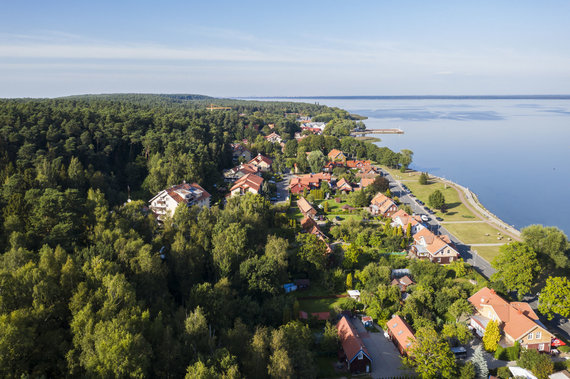
Luke April / 15min photo / Juodkrante
Like on a “desert island”
What was the atmosphere like in the Juodkrante complex in the second half of the 19th century? In the book, the author quotes the memories of the people who visited here at the time, one of them, Ludwig Passargė, who left the ship by ship and described his impressions as if he were on a “desert island”, but the impression was erased by good coffee and a nice holiday company. He also mentions the fun adventures here and the fact that he had to listen to sentimental poems.
In the big hotel, I found a host with their inns over the cafe who drank at the same time, like a family, ladies and gentlemen still dressed in morning clothes.
The book says: “Otto Glagau also wrote about the” rules of the game “of the emerging complex:” In the big hotel I found a host with his house next to the cafe that they all drank at once, like a family, ladies and gentlemen who they still wear morning clothes. “Passarge also described the very modest life of the tourists at the Stellmacher guest house: a small room with simple planks, a table, two chairs, a bed and a small round mirror, and the accent of This “luxurious interior” is a series of “terribly large crooked nails.” To the border. ” It is true that it is not known whether Passargė described the facilities of the old tavern or another large building intended to rent rooms. “
The Curonian people looked exotic
How did tourists view the locals? According to the author of the book, this has changed over time. As an example, he mentioned the impressions of a gentleman, in 1878 he arrived during the holiday season, which is already fading, when everything follows the usual rhythm: a walk along the promenade, a stay by the sea.
However, he also writes that one day there was a change in this uniform rhythm: a villagers’ wedding was held. According to the author of the book, the locals described the locals as follows: “The Curonian fishermen speak Curonian, but also German.” Later he describes weddings, customs, gifts, decorations. “In the last quarter of the 19th century, intellectuals in big cities knew that there was a national minority and it was very interesting for them, otherwise the newcomer would not have gone to the wedding,” said the researcher.
He compared the times to the interwar period, when the locals became part of the complex, rented rooms, sold fish, and newcomers were tired of them, and local fishermen were no longer as exotic as they were in the late 1800s. .
What was the air and the water like?
As the author of the book says, the weather in the late 19th century was taken as seriously as it is now, and from 1876 to 1900 the weather was regularly monitored.
In August 1902, when the water in the Baltic Sea was warmer, the average temperature reached 15.1 degrees, making the sea warmer now.
For those who want to know what it meant to have a beach vacation at the time, the facts are that the average temperature near Mēmelis was 17.4 degrees in July and 19.1 degrees in August.
In August 1902, when the water in the Baltic Sea was warmer, the average temperature reached 15.1 degrees, making the sea warmer now.
At the end of the 19th century, rainfall was 619 millimeters, now 750 millimeters. So now we have more rain on the coast.
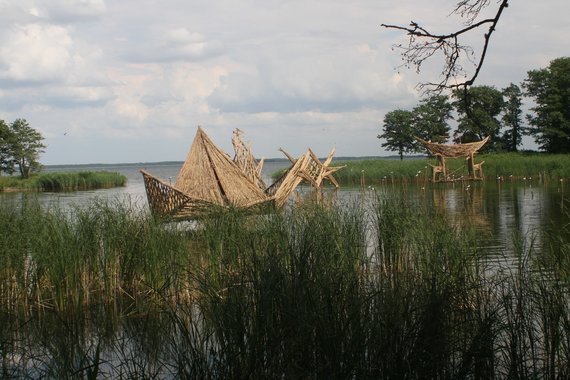
Photo by Alvydas Januševičius / 15min photo / Bike trip to Juodkrante
To the resort, not to swim, but to find a partner.
It is true that for many tourists, at least in the late 19th century, bathing in the Baltic Sea was not very important. While hygienists have tried to convince people that cold seawater is also good for health, many have not been convinced. Instead, people turned to other entertainments, let’s say sand baths that may now seem exotic to us, or slightly cheaper mud or carbon dioxide baths.
Many did not go to sea for another reason: they did not come to the resorts for that purpose. It was not uncommon to go to the beach to find a partner, and afternoons of dancing, walks along the promenade, meeting or escorting steamboats at the marina, and reading rooms in larger woven hotels acquaintances were more suitable than bathing.
It was not uncommon to go to the beach to find a partner, and afternoons of dancing, walks along the promenade, meeting or escorting steamboats at the marina, and reading rooms in larger woven hotels acquaintances were more suitable than bathing.
Incidentally, already at the end of the 19th century, the medical and hygienic situation in tourist centers was taken seriously: each center had to have a doctor, as well as a corpse and adequate disinfectants.
The hygienic situation at the Curonian Spit at the time can be deduced from this entry in the 1913 publication on Nida: “Large guest houses have toilets with discharge equipment, and faeces are otherwise collected in wells. Some of the simpler guesthouses have wellless bathrooms. Waste is generally disposed of by the owners themselves and used in the home. The sewage from the house seeps into the sandy soil. ”
We are losing the locals
What has been lost the most since then? According to the author of the book, an investigator of the history of Juodkrante, when a decision was made about the Neringa center in 1960, there were two variants: Juodkrantė and Nida. In the end, it was decided to make Nida a center, and partly because of that, Juodkrante was lucky, according to N. Strakauskaitė, as a result, some of the unsuccessful constructions that took place in Nida did not occur in Juodkrante.
However, she notes that the nature around Juodkrante has been severely destroyed in recent years. “The abandoned Juodkrante forest park was a decoration of the complex, the boardwalks, and we are destroying the place,” said the researcher, who showed the audience photos of forest trails destroyed by various vehicles.
“And the biggest loss is the loss of people who live permanently. As of 2016, there is no school here, which means that there will be people who will come in the summer, but there will be no people who live permanently, “said the author, who still lives in Juodkrante.
He also said that, unfortunately, in the second half of the 20th century, the history of the Curonian Spit was not studied at all: in Soviet times, everything German was considered suspicious. “We grew up with tales,” N. Strakauskaitė described the earliest historical sources. And it was only after 1990 that the history of Juodkrante as well as other Curonian Spit villages began to be investigated, which was encouraged by the locals, who still remember the interwar period.
[ad_2]